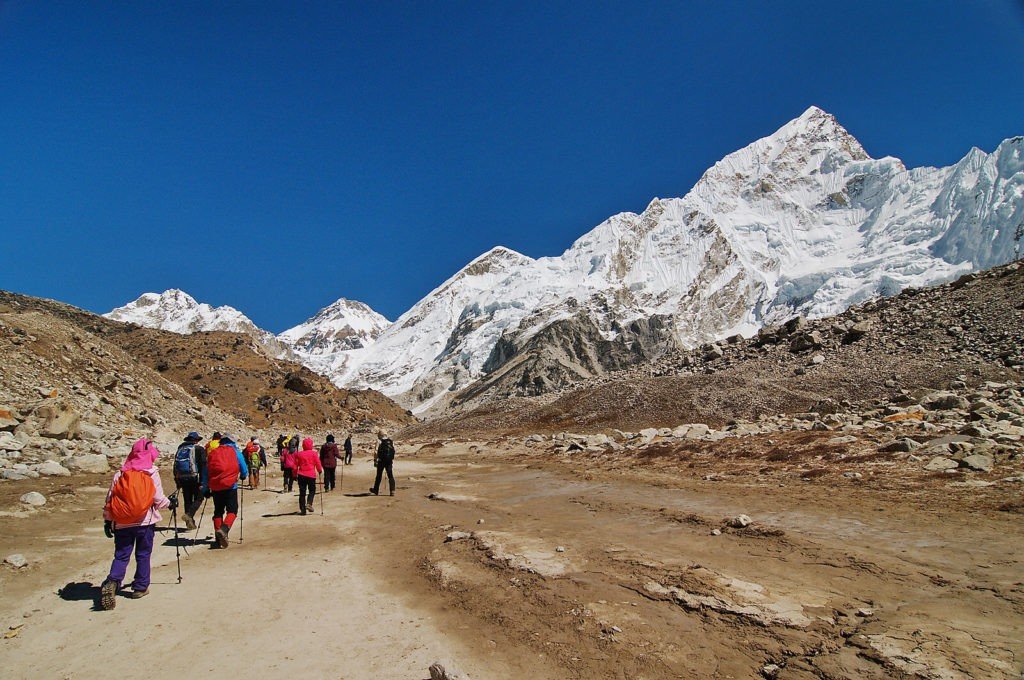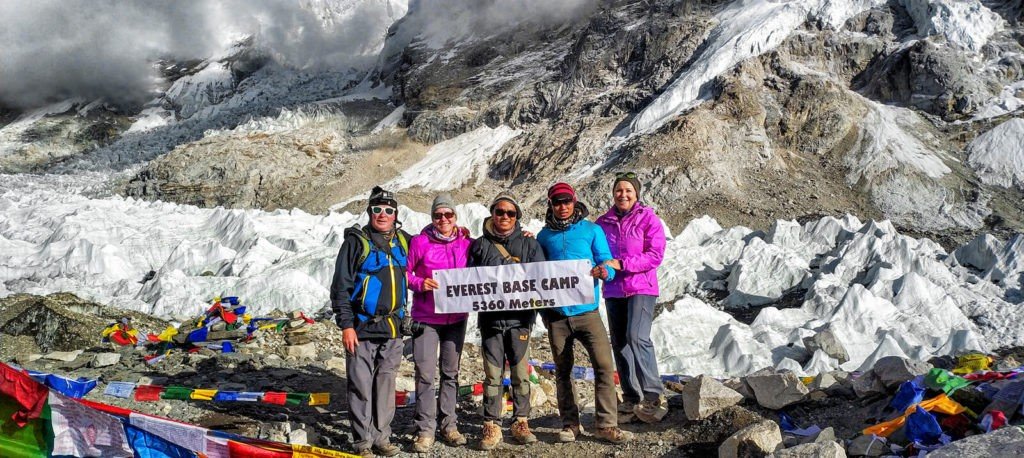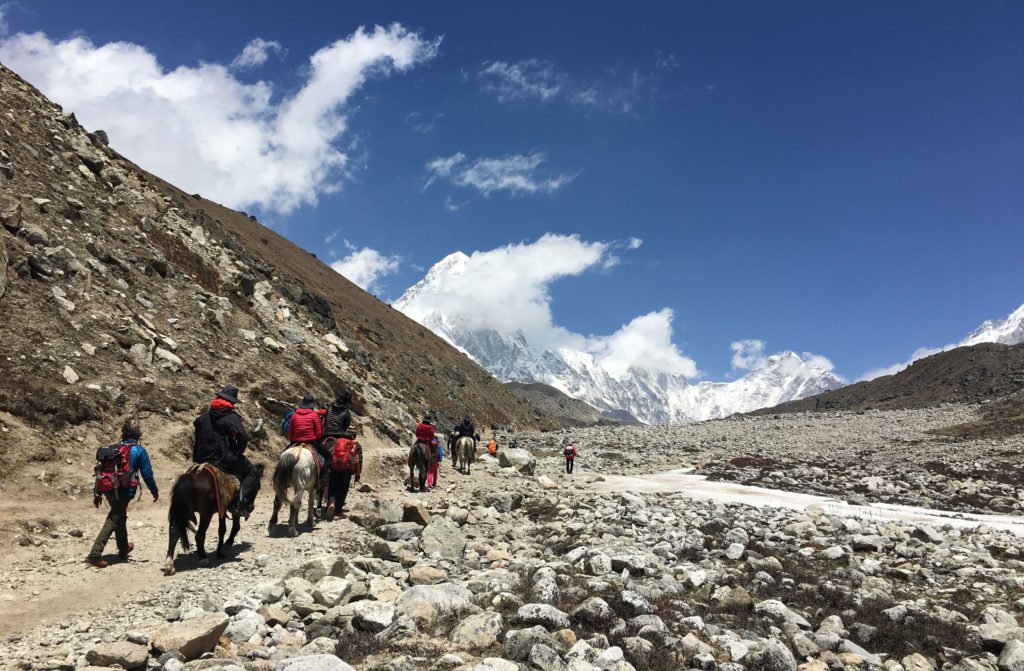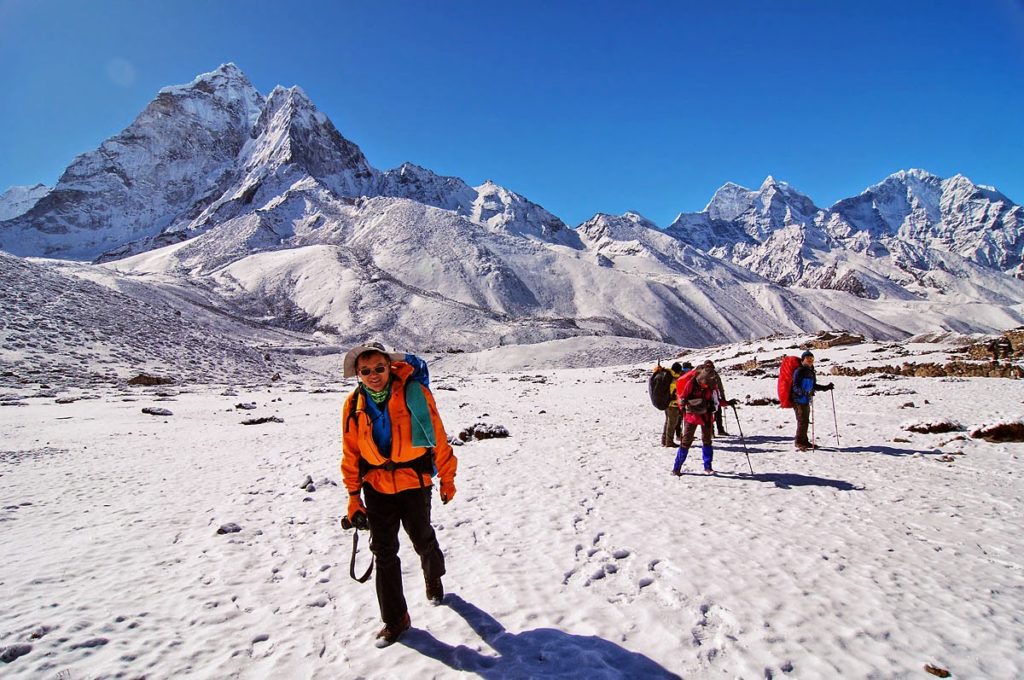Everest Base Camp Trek, without a doubt, is the best trekking experience you will ever have. Watching Everest standing so close and the 360-degree view of the glacial, flame crystal mountain will be an unforgettable memory for you. You'll be in awe standing in front of a high and cold, glacial Mt Everest. Your journey will be filled with the beauty of the Khumbu region. The stunning mountain ranges are unlike any of the ones that you have ever seen in your life.
As you progress during the trek, the beauty outshines anything you have laid eyes on—the terrain changes from green farmlands to lush jungles, colorful flowers, and clear blue rivers. You won't be experiencing any more significant achievement and adventure better than this. Nepal for all seasons isn't an understatement. God has graciously blessed Nepal with beautiful weather. All four seasons, spring, summer, autumn, and winter, have spread their wings in this country. This helps Nepal show off its charms in every kind of weather.
Tourism is the primary source of Nepal's economy. And with favorable weather throughout the whole year, trekking has become one of Nepal's popular adventure activities. The Everest Base Camp trek has much to offer at any given temperature. The Everest base camp seems beautiful in all seasons. Just read more to choose the perfect season for you to trek.
Autumn (September-November)

From September to November, autumn starts. This is the peak season for Everest Base Camp Trek as the weather becomes more comfortable for trekking. Autumn initiates at the end of the monsoon season, and as there are no rainfalls, soft trekking can be planned during that time. It is the perfect period to trek as the weather is neither too hot nor too cold.
Weather difficulties like summer heat haze and windy weather won't be a problem. This offers a clear blue sky, crystal clear views of Mt. Everest and surrounding peaks.
September
September in Everest region offers pleasant weather, with temperatures ranging from 21°C to 10°C in Lukla, 17°C to 6°C in Namche Bazaar, and 8°C to -2°C in Gorak Shep.
October
Regarding the time of October in the Sagarmatha National Park, it's another peak trekking time to enroll in Everest with perfect weather conditions. Temps range from 17°C to 6°C in Lukla, 13°C to 1.4°C in Namche, and 5.4°C to -8.9°C in Gorak Shep.
November
November in EBC brings dry and cold weather, with clear surroundings and no rainfall after monsoon. The temps are similar to those in October; even if it is mild in daytime, the temps can plunge to - 10 degrees Celsius at night.
Overall, Autumn season ranges from an average of 15 to 25 degrees Centigrade. With an increase in altitude, the temperature drops significantly, comprising nearly -10 Celsius at night. Favorable, good weather makes the trekking smooth, on schedule, and stress-free.
Spring (March-May)

Everest Base Camp Trekking in spring has the 2nd highest number of trekkers from all around the world. Spring brings colorful landscapes and lush forests with it. The weather is kindest in spring at Everest Base Camp. The rhododendron (National flower of Nepal) trees garnish the trails, making them insanely beautiful. Colorful flowers bloom in the houses and the parks around.
In Kathmandu, the temperature ranges from 15 to 20 degrees Centigrade. With an increase in the altitude, the temperature drops to -2-10 degrees Centigrade.
March
The weather conditions during Everest Base Camp trek in March is generally mild, with average highs of 15–20°C during the day and lows of -5–0°C at night. However, temperatures can drop -7 to -12°C in the mornings and evenings.
April
Trekking to Everest base Camp in April can be a pleasant experience, as the temperatures are warm, making it one of the best times of the year to start a tour to EBC. Between Lukla and Namche, it ranges from 2-3°C (max) to -7°C (min). However, high altitudes can plummet to - 14°C. At Everest Base Camp and Kala Patthar, the normal max temperature is 1°C - 3°C.
May
May is one of the busy spring seasons in the Mountains of Nepal, including EBC trek. Lower elevations like Lukla and Phakding are warmer, with temperatures of 15 – 19 degrees Celsius, yet the temps can experience a drastic fall at night. May, at the foothill of world’s highest mountain, is 6° C at its max, and the minimum middling temps is -4° C.
Overall, in Spring, the snow-capped Himalayas add the beauty of nature even more; as the days are longer, you have plenty of time to walk at your pace and still complete trekking in the daylight. The chances of avalanches and heavy snowfall during the hike are rare. Compared to other seasons, the crowd is relatively less, which gives you a feeling of peace while enjoying your trekking in Everest Base Camp.
Moreover, it is also a good time for the flight from Kathmandu to Lukla and Helicopter rides, making spring a festive period for a smooth trek.
Monsoon (June-August)

Monsoon/Summer in Nepal begins from June and to the end of August or more. Nepal has an average rainfall of 500-550 mm. The temperature gets hot and humid. It reaches a maximum of 10° C and a minimum of -2° C.
Because of rain, the cloud covers the sky. And sometimes, the sky clears up in the morning, providing a serene view of Mt Everest. The vegetation becomes greener because of the rainfall, and the views of the jungles and mountains are fantastic.
June
In June, the initial days may be dry, but as it reaches mid-June, we expect lots of rainfall. Basically, the normal temps in Lower Khumbu region stood at 22 degrees centigrade, while higher Sherpa villages witness temperatures dip below -1 to 3 degrees centigrade at night even though days are warmer.
July
In the month of July, Everest region sees daytime highs of around 22°C and nighttime lows of 12°C in the lower villages of Khumbu. Gorak Shep, being at a higher altitude, is colder, with temperatures dropping to 0°C. Early mornings are often clear, but as the day passes, rain tends to fall, particularly in the afternoons and evenings.
August
Lastly, August is also an adoable season with some challenges but rewarding for those seeking an absolutely exceptional experience. Khumbu region experiences heavy rainfall in the lower altitudes, while areas above 4000m remain dry, with some snowfall at higher elevations. Temps stay mild, with Lukla constituting 22 degrees Celsius, Namche just below 20°C, and Gorakshep approximately 4°C.
Monsoon season is considered off-season, but for travelers, the season has its own charm; with more discounts and fewer crowds on the Everest trekking trails, one can enjoy peace in nature with more availability of tea houses and amenities.
Even though there are some challenges, such as the muddy, wet, and slippery paths it can be easily completed with good-quality boots with solid grips and waterproof clothes. Everest Base Camp Trek in the monsoon is a little harder, but one experience, the unique biodiversity of Khumbu, and a new adventure.
Winter (December-February)

Trek to Everest Base Camp in winter is too harsh. The temperatures frequently change and range between -10° C to -15 ° C at night and can't be predicted as the climate changes from a sunny day to a snowstorm. Nevertheless, the trails are less crowded, making the trek easier to walk and spot the best views. If one is well-prepared and can endure the harsh weather, trekking in EBC in this season is the best as they can trek without any obstruction. But one has to choose the perfect month.
December
During December, the weather at Everest is very cold at night as well as in morning, reaching an average minimum of - 15 degrees Celsius. However, daytime is reasonable, ranging from 15 to 20 degrees Celsius.
January
January, on the other hand, is also an off-season month in Everest. The biting chill of cold wintertime keeps the trekkers away. In high areas of Everest above 5000m, the minimum average temperature falls down to around - 15 to - 20 degrees Celsius. In the lower valleys of Sherpa, it remains a little warmer in the daytime and dips below -6 degrees Celsius at night.
February
Average temperature on Everest trail during February hovers around -3°C. Lukla, at 2,860 meters, is the warmest, with a maximum of 10°C, while Gorak Shep is the coldest, with a maximum of -15°C. Days begin to lengthen, offering more daylight than in Dec and Jan.
During winter season, weather is challenging and cold, but the view of snow-capped Mount Everest and the surrounding peaks makes the struggle worth it. Wintertime trekking is ideal as the routes have fewer crowds. However, it is pretty risky, so you have to gather as much information as you can and get a professional trekking guide to go through this trip.
The days are shorter during this season, so there is less time to trek each day. But with proper preparation and highly recommended trekking gear like sleeping bags, down jackets, and others, you can reach Everest Base Camp safely.
Everest Base Camp Trek Temperature and Weather Guide
| Month | Maximum (°C) | Maximum (°F) | Minimum (°C) | Minimum (°F) |
| January | 10 | 50 | -15 | 5 |
| February | 10 | 50 | -15 | 5 |
| March | 14 | 57.2 | -10 | 14 |
| April | 15 | 59 | -5 | 23 |
| May | 18 | 64.4 | -4 | 24.8 |
| June | 20 | 68 | -2 | 28.4 |
| July | 20 | 68 | -2 | 28.4 |
| August | 20 | 68 | -2 | 28.4 |
| September | 18 | 64.4 | -5 | 23 |
| October | 15 | 59 | -7 | 19.4 |
| November | 13 | 55.4 | -12 | 10.4 |
| December | 10 | 50 | -15 | 5 |
Frequently Asked Questions About EBC Trek for All Seasons
Discover answers to common questions about the Everest Base Camp trek, covering seasons, trail conditions, packing tips, acclimatization, and more to help you prepare.
What is the best time of year to trek to Everest Base Camp?
The most popular seasons for the Everest Base Camp Trek are spring (March to May) and autumn (September to November). During these times, the weather is generally stable, offering clear skies and moderate temperatures, making for an enjoyable trekking experience.
How cold does it get during the winter trek to Everest Base Camp?
In winter (December to February), temperatures can drop significantly, especially at higher altitudes. Daytime temperatures may range from -10°C to -15°C (14°F to 5°F), with nights being even colder. Despite the cold, winter treks offer serene landscapes with fewer trekkers on the trails.
Are there any risks of avalanches during the spring season on the Everest Base Camp Trek?
The risk of avalanches during the spring season is generally low, making it a safer time for trekking. The weather is relatively stable, and the trails are adorned with blooming rhododendrons, enhancing the trekking experience.
How does the altitude affect temperatures during the Everest Base Camp Trek?
As you ascend to higher altitudes, temperatures decrease. For instance, at higher elevations, daytime temperatures can be around 20°C (68°F), dropping to -10°C (14°F) at night. It's crucial to be prepared for these variations by packing appropriate clothing to stay comfortable throughout the trek.
What kind of clothing should I pack for the Everest Base Camp trek in different seasons?
The clothing you pack depends on the season. In spring and autumn, layers are essential for fluctuating temperatures. During winter, heavy thermal wear, down jackets, and warm gloves are necessary. In monsoon, waterproof gear like rain jackets and ponchos is crucial.
Are the trails crowded during peak trekking seasons?
Yes, spring and autumn are the most popular seasons, so the trails and teahouses tend to be busier. If you prefer quieter trails, consider trekking in the winter or monsoon season, but be prepared for additional challenges.
How do the landscapes and views differ across seasons on the trek?
Spring: Vibrant rhododendron blooms and clear skies.
Monsoon: Green and lush landscapes with occasional cloudy views.
Autumn: Crystal-clear skies and panoramic mountain views.
Winter: Snow-covered trails and serene, quiet paths.
What are the challenges of trekking during the monsoon season?
The monsoon brings heavy rains, muddy trails, and leeches. However, the vibrant greenery and fewer crowds can make it a unique experience. Ensure you have proper waterproof gear and flexible travel plans due to potential flight delays.
Can beginners attempt the Everest Base Camp trek in any season?
Yes, beginners can attempt the trek with proper preparation, guidance, and acclimatization. However, trekking in the winter or monsoon season may require extra effort due to weather challenges. Hiring a guide and porter is highly recommended for first-timers.
Are there any seasonal differences in accommodation availability along the trek?
In peak seasons (spring and autumn), accommodations can fill up quickly, so early bookings are advised. During winter and monsoon, availability is less of an issue, but some teahouses may be closed in more remote areas.
How does the weather affect flights to and from Lukla?
Flights to Lukla are highly weather-dependent. In monsoon and winter, delays or cancellations are common due to poor visibility. It’s advisable to plan extra buffer days and consider travel insurance that covers flight disruptions.
What are the best tips for acclimatizing during the trek in all seasons?
Acclimatization is crucial for a safe and enjoyable trekking experience, regardless of the season. First, ensure you take rest days as outlined in your itinerary, allowing your body sufficient time to adapt to the altitude. Staying hydrated is essential, so drink plenty of water and avoid alcohol, as it can exacerbate dehydration and altitude-related symptoms.
Ascend gradually, following the recommended elevation gains to reduce the risk of altitude sickness. Finally, familiarize yourself with the symptoms of Acute Mountain Sickness (AMS), such as headaches, dizziness, or nausea, and notify your guide immediately if you notice any signs.
These practices are vital for adapting to the changing altitude and ensuring a successful trek.
What wildlife can you spot during different seasons on the Everest Base Camp trek?
Spring: The trails are vibrant with Himalayan Monals, Nepal's national bird, known for their colorful plumage. Butterflies of various species are also commonly spotted, adding to the beauty of the season.
Monsoon: Amphibians thrive during the rainy season, and the lush greenery creates a perfect environment for diverse flora and smaller wildlife. The monsoon brings the landscape to life with an abundance of activity in the lower altitudes.
Autumn: This season provides excellent visibility, making it easier to spot larger animals like the Himalayan Thar. With a bit of luck, trekkers might catch a glimpse of the elusive snow leopard in remote areas, though sightings are rare.
Winter: Wildlife sightings decrease in winter due to the harsh cold, but trekkers may still encounter high-altitude species. The snow-covered trails offer a serene backdrop, making it a magical time to appreciate the environment's stillness and beauty.
Each season offers its unique blend of wildlife experiences, adding a rich layer to the trekking adventure.
What are the pros and cons of trekking in spring vs. autumn?
Trekking in spring comes with the advantage of warmer weather, vibrant blooming flowers, and fewer risks of encountering icy trails. However, spring also has its drawbacks, such as slightly hazy skies that can obscure mountain views and occasional rain at lower altitudes.
On the other hand, autumn offers crystal-clear skies, dry trails, and excellent visibility, making it ideal for breathtaking views and photography.
Despite these benefits, autumn can be cooler, especially at higher altitudes, and the trails are generally busier due to the season’s popularity among trekkers.
What are the pros and cons of trekking in winter vs. summer?
Trekking in winter offers serene, snow-covered landscapes and fewer crowds, making it an excellent choice for those seeking solitude. The crisp, clear skies provide breathtaking views of the mountains. However, the colder temperatures, especially at higher altitudes, and the possibility of icy trails can be challenging. Some teahouses in remote areas may also be closed due to the harsh weather.
In contrast, summer (monsoon season) brings lush, green landscapes and vibrant flora, creating a unique and beautiful trekking experience. The trails are less crowded, but trekkers must contend with frequent rainfall, muddy paths, and leeches in the lower regions.
Additionally, cloud cover may obscure mountain views, and flight delays to Lukla are more common during this season.
Proper preparation is essential for a safe and enjoyable trek in either season.
Conclusion
Everest Region welcomes trekkers from all over the world, offering everything from iconic and legendary Everest Base Camp Trek to side trips like Gokyo Lakes or a High passes trek. Whether you want to explore the region of Khumbu Valley or get involved in Sherpa culture, Everest Base Camp trekking is perfect for you.
Pick the time that suits you best. If you are interested, contact and join Nepal Hiking Team now, and we will be more than happy to help you to make your trip to Everest a perfect trekking experience.



Post a Comment